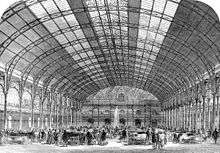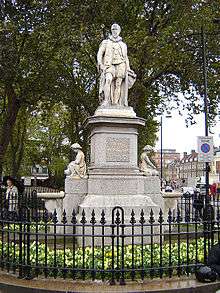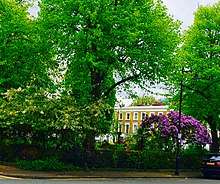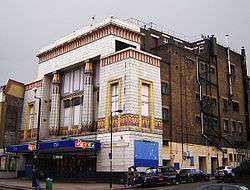Islington
Islington (/ˈɪzlɪŋtən/) is a district in Greater London, England, and part of the London Borough of Islington. It is a mainly residential district of Inner London, extending from Islington's High Street to Highbury Fields, encompassing the area around the busy High Street, Upper Street, Essex Road (former "Lower Street"), and Southgate Road to the east.
| Islington | |
|---|---|
Buildings on Islington High Street | |
 Islington Location within Greater London | |
| Area | 14.86 km2 (5.74 sq mi) (whole Borough) |
| Population | 206,125 (2011 census) (whole borough)[1] |
| • Density | 13,871/km2 (35,930/sq mi) |
| OS grid reference | TQ315844 |
| London borough | |
| Ceremonial county | Greater London |
| Region | |
| Country | England |
| Sovereign state | United Kingdom |
| Post town | LONDON |
| Postcode district | N1,EC1 |
| Dialling code | 020 |
| Police | Metropolitan |
| Fire | London |
| Ambulance | London |
| UK Parliament | |
| London Assembly | |
Modern definition
Islington grew as a sprawling Middlesex village along the line of the Great North Road, and has provided the name of the modern borough. This gave rise to some confusion, as neighbouring districts may also be said to be in Islington. This district is bounded by Liverpool Road to the west and City Road and Southgate Road to the south-east. Its northernmost point is in the area of Canonbury. The main north–south high street, Upper Street splits at Highbury Corner to Holloway Road to the west and St. Paul's Road to the east.
The Angel business improvement district (BID), an area centered around the Angel tube station, exists within southern Islington district and northern portions of two other districts in the London Borough of Islington – Finsbury and Pentonville.
History

Etymology
Islington was originally named by the Saxons Giseldone (1005), then Gislandune (1062). The name means "Gīsla's hill" from the Old English personal name Gīsla and dun ("hill", "down"). The name later mutated to Isledon, which remained in use well into the 17th century when the modern form arose.[2][3] In medieval times, Islington was just one of many small manors thereabouts, along with Bernersbury, Neweton Berewe or Hey-bury and Canonesbury (Barnsbury, Highbury and Canonbury – names first recorded in the 13th and 14th centuries).
Origins


Some roads on the edge of the area, including Essex Road, were known as streets by the medieval period, possibly indicating a Roman origin, but little physical evidence remains. What is known is that the Great North Road from Aldersgate came into use in the 14th century, connecting with a new turnpike (toll road) up Highgate Hill. This was along the line of modern Upper Street, with a toll gate at The Angel defining the extent of the village. The Back Road, the modern Liverpool Road, was primarily a drovers' road where cattle would be rested before the final leg of their journey to Smithfield. Pens and sheds were erected along this road to accommodate the animals.[4]
The first recorded church, St Mary's, was erected in the twelfth century and was replaced in the fifteenth century.[5] Islington lay on the estates of the Bishop of London and the Dean and Chapter of St Pauls. There were substantial medieval moated manor houses in the area, principally at Canonbury and Highbury. In 1548, there were 440 communicants listed and the rural atmosphere, with access to the City and Westminster, made it a popular residence for the rich and eminent.[2] The local inns harboured many fugitives and sheltered recusants.
The Royal Agricultural Hall was built in 1862 on the Liverpool Road site of William Dixon's Cattle Layers. The hall was 75 ft high and the arched glass roof spanned 125 ft. It was built for the annual Smithfield Show in December of that year but was popular for other purposes, including recitals and the Royal Tournament. It was the primary exhibition site for London until the 20th century and the largest building of its kind, holding up to 50,000 people.[6] It was requisitioned for use by the Mount Pleasant sorting office during World War II and never re-opened. The main hall has now been incorporated into the Business Design Centre.[7]
Water sources

The hill on which Islington stands has long supplied the City of London with water, the first projects drawing water through wooden pipes from the many springs that lay at its foot, in Finsbury. These included Sadler's Wells, London Spa and Clerkenwell.
By the 17th century these traditional sources were inadequate to supply the growing population and plans were laid to construct a waterway, the New River, to bring fresh water from the source of the River Lea, in Hertfordshire to New River Head, below Islington in Finsbury. The river was opened on 29 September 1613 by Sir Hugh Myddelton, the constructor of the project. His statue still stands where Upper Street meets Essex Road. The course of the river ran to the east of Upper Street, and much of its course is now covered and forms a linear park through the area.[8]
The Regent's Canal passes through Islington, for much of which in an 886-metre (2,907 ft) tunnel that runs from Colebrook Row east of the Angel, to emerge at Muriel Street near Caledonian Road. The stretch is marked above with a series of pavement plaques so walkers may find their way from one entrance to the other. The area of the canal east of the tunnel and north of the City Road was once dominated by much warehousing and industry surrounding the large City Road Basin and Wenlock Basin. Those old buildings that survive here are now largely residential or small creative work units. This stretch has an old double-fronted pub The Narrowboat, one side accessed from the towpath.
The canal was constructed in 1820 to carry cargo from Limehouse into the canal system. There is no tow-path in the tunnel so bargees had to walk their barges through, braced against the roof.[9] Commercial use of the canal has declined since the 1960s.
Market gardens and entertainments
In the 17th and 18th centuries the availability of water made Islington a good place for growing vegetables to feed London. The manor became a popular excursion destination for Londoners, attracted to the area by its rural feel. Many public houses were therefore built to serve the needs of both the excursionists and travellers on the turnpike. By 1716, there were 56 ale-house keepers in Upper Street, also offering pleasure and tea gardens, and activities such as archery, skittle alleys and bowling. By the 18th century, music and dancing were offered, together with billiards, firework displays and balloon ascents. The King's Head Tavern, now a Victorian building with a theatre, has remained on the same site, opposite the parish church, since 1543.[7] The founder of the theatre, Dan Crawford, who died in 2005, disagreed with the introduction of decimal coinage. For twenty-plus years after decimalisation (on 15 February 1971), the bar continued to show prices and charge for drinks in pre-decimalisation currency.
By the 19th century many music halls and theatres were established around Islington Green. One such was Collins' Music Hall, the remains of which are now partly incorporated into a bookshop. The remainder of the Hall has been redeveloped into a new theatre, with its entrance at the bottom of Essex Road. It stood on the site of the Landsdowne Tavern, where the landlord had built an entertainment room for customers who wanted to sing (and later for professional entertainers). It was founded in 1862 by Samuel Thomas Collins Vagg and by 1897 had become a 1,800-seat theatre with 10 bars. The theatre suffered damage in a fire in 1958 and has not reopened. Between 92 and 162 acts were put on each evening and performers who started there included Marie Lloyd, George Robey, Harry Lauder, Harry Tate, George Formby, Vesta Tilley, Tommy Trinder, Gracie Fields, Tommy Handley and Norman Wisdom.

The Islington Literary and Scientific Society was established in 1833 and first met in Mr. Edgeworth's Academy on Upper Street. Its goal was to spread knowledge through lectures, discussions, and experiments, politics and theology being forbidden. A building, the Literary and Scientific Institution, was erected in 1837 in Wellington (later Almeida) Street, designed by Roumieu and Gough in a stuccoed Grecian style. It included a library (containing 3,300 volumes in 1839), reading room, museum, laboratory, and lecture theatre seating 500. The subscription was two guineas a year. After the library was sold off in 1872, the building was sold or leased in 1874 to the Wellington Club, which occupied it until 1886. In 1885 the hall was used for concerts, balls, and public meetings. The Salvation Army bought the building in 1890, renamed it the Wellington Castle barracks, and remained there until 1955. The building became a factory and showroom for Beck's British Carnival Novelties for a few years from 1956, after which it stood empty. In 1978 a campaign began with the goal to redevelop the building as a theatre. A public appeal was launched in 1981, and a festival of avant-garde theatre and music was held there and at other Islington venues in 1982. What has become the successful Almeida Theatre was founded.
Housing
Some early development took place to accommodate the popularity of the nearby Sadler's Wells, which became a resort in the 16th century, but the 19th century saw the greatest expansion in housing, soon to cover the whole parish. In 1801, the population was 10,212, but by 1891 this had increased to 319,143. This rapid expansion was partly due to the introduction of horse-drawn omnibuses in 1830. Large well-built houses and fashionable squares drew clerks, artisans and professionals to the district. However, from the middle of the 19th century the poor were being displaced by clearances in inner London to build the new railway stations and goods yards. Many of the displaced settled in Islington, with the houses becoming occupied by many families. This, combined with the railways pushing into outer Middlesex, reduced Islington's attraction for the "better off" as it became "unfashionable".[10] The area fell into a long decline; and by the mid-20th century, it was largely run-down and a byword for urban poverty.[2]
The aerial bombing of World War II caused much damage to Islington's housing stock, with 3,200 dwellings destroyed. Before the war a number of 1930s council housing blocks had been added to the stock. After the war, partly as a result of bomb site redevelopment, the council housing boom got into its stride, reaching its peak in the 1960s: several extensive estates were constructed, by both the Metropolitan Borough of Islington and the London County Council. Clearance of the worst terraced housing was undertaken, but Islington continued to be very densely populated, with a high level of overcrowding. The district has many council blocks, and the local authority has begun to replace some of them.
From the 1960s, the remaining Georgian terraces were rediscovered by middle-class families. Many of the houses were rehabilitated, and the area became newly fashionable. This displacement of the poor by the aspirational has become known as gentrification. Among the new residents were a number of figures who became central in the New Labour movement, including Tony Blair before his victory in the 1997 general election. According to The Guardian in 2006, "Islington is widely regarded as the spiritual home of Britain's left-wing intelligentsia."[11] The Granita Pact between Gordon Brown and Tony Blair is said to have been made at a now defunct restaurant on Upper Street.[12]
The African National Congress's headquarters in-exile was based on Penton Street. It was the target of a bomb attack in 1982.
The completion of the Victoria line and redevelopment of Angel tube station created the conditions for developers to renovate many of the early Victorian and Georgian townhouses. They also built new developments. Islington remains a district with diverse inhabitants, with its private houses and apartments not far from social housing in immediately neighbouring wards such as Finsbury and Clerkenwell to the south, Bloomsbury and King's Cross to the west, and Highbury to the north west, and also the Hackney districts of De Beauvoir and Old Street to the north east.
Islington is the most densely populated borough in the UK according to the 2011 census, with a population density of 138.7 people per hectare, compared to an average of 52.0 for London.
Upper Street
Upper Street is the main shopping street of central Islington, and carries the A1 road.
Islington High Street
Islington High Street is the former High Street of the original village of Islington. High Street runs approximately 500 metres (0.31 mi) from the intersection of Pentonville Road and City Road at the south end to Islington Green at the north end, where it branches into Upper Street and Essex Road (former Lower Street) – though some maps may simply show High Street as the southern portion of Upper Street. The earliest reference to Islington High Street is its appearance on a 1590 map of the area. At this time, nine inns (including the famous Angel, which has subsequently given its name to the area around High Street), as well as housing and a public pond were shown lining the street.[13] Then as now, Islington was and is unusual in that the village church, St Mary's, does not stand on the high street but is some way off on Upper Street.
In 1716 Islington High Street came under the control of the newly formed Islington Turnpike Trust. The Trust grew rapidly, and soon had control of most major roads in the area, building a number of major road arteries through the expanding residential areas, including Caledonian Road, Euston Road, City Road and New North Road.[14]
The Peacock Inn[15] at 11 Islington High Street dates from 1564, although the current façade dates from 1857. It featured in Tom Brown's Schooldays as the inn at which Tom stays prior to travelling to Rugby School. It closed in 1962, although the building still stands.[16]
Angel tube station on Islington High Street has the longest escalator on the London Underground system, at 318 steps.[17] In 2006 a Norwegian man made headlines after skiing down the escalator at the station.[18]
In literature
Islington features extensively in modern English literature and culture:
Books
- In the Harry Potter series by JK Rowling, the Order of the Phoenix is headquartered at Number 12 Grimmauld Place, a fictitious street in Islington. The house belonged to Sirius Black and Harry, Ron, and Hermione used it as a hideout in Harry Potter and the Deathly Hallows.
- Douglas Adams lived in Arlington Avenue. The phone number of his house was 226 7709. In The Hitchhiker's Guide to the Galaxy when Arthur Dent and Ford Prefect are rescued in ZZ9 Plural Z Alpha, the probability of that happening was 2 to the power of 267,709 to one against. Douglas also used Islington as a setting in his novels, and named a character in his famous Hitchhikers' Guide to the Galaxy (1978) series, Hotblack Desiato, after a well-known local estate agent. Islington was also the place in which Arthur Dent meets Trillian during a party in a flat.
- In Adams' Dirk Gently series, Dirk's Holistic Detective Agency, Richard MacDuff's flat, and Susan Way's flat are all in Islington (though Dirk's office is on a fictional street).
- The Wilfers of Holloway feature in Charles Dickens' Our Mutual Friend (1864–65).
- Emma Evans, protagonist of Margaret Drabble's novel The Garrick Year (1964), lives, after she has married her husband David, in "an ordinary nineteenth-century terrace house in Islington, and on either side of the front door stood a small stone lion the back garden was up to the standard of the lions".
- In Neil Gaiman's best-selling novel Neverwhere, Islington is a fallen angel that lives under London, named after the Angel tube station.
- Simon Gray's play Otherwise Engaged (1975) is set in Islington.
- Martha Grimes' fictional detective, Richard Jury, lives in a flat in Islington.
- Im The Diary of a Nobody (first serialized in Punch magazine in 1888–89 and first printed in book form, in 1892), an English comic novel written by George Grossmith and his brother Weedon Grossmith, the main character lives off the Holloway Road in Brickfield Terrace.
- Zoë Heller's novel Notes on a Scandal (2003) is set in Islington.
- Islington features throughout Charlie Higson's post-apocalyptic, young adult horror series, The Enemy, set in and around London. For example, in The Dead (2010), Islington is the destination of the group traveling on Greg's bus. Greg tells everyone but his son, Liam: "Get some sleep. We'll push on in the morning. I'll take you all as far as Islington. After that you're on your own."[19]
- Nick Hornby's novels About a Boy and Slam are set in Islington.[20]
- Islington is referred to in the M. R. James short ghost story "Two Doctors" published in A Thin Ghost and Others in 1919.
Opera
- In Arthur Sullivan and B. C. Stephenson's comic opera, The Zoo (1875), two of the main characters are the Duke of Islington and his beloved, whom he asks to become the Duchess of Islington.
Poetry
- Abraham Cowley's poem "Of Solitude" (1668) mentions this area in the conclusion of the poem (but not the essay of the same name, which is more common).
Transport
The area is well served by bus routes, with a major bus interchange located near Angel tube station. Red route and residents' parking restrictions apply throughout the area.
Nearby places
Nearby stations
Education
Government and infrastructure
The Civil Aviation Authority has its head office in the CAA House in Islington.[21]
Listed buildings



Grade II*
English Heritage[22] list three Grade II* listed buildings within Central Islington (and many more in surrounding districts):
- The Union Chapel
- 3 Terrett's Place (an 18th-century house on Upper Street)
- St Paul's Church, St Paul's Road (designed by Sir Charles Barry, now the St Paul's Steiner Project)
- Finsbury Town Hall
Grade II (selected):
The area contains numerous Georgian townhouses, shops and pubs. Many whole terraces are listed including much of Liverpool Road (one side of which is in Barnsbury) and Islington High Street/Upper Street. Other multiply listed streets include Arlington Square (one of the UK's top 10 garden squares)[23] Camden Passage, Compton Terrace, Colebrooke Row, Cross Street, Duncan Terrace, Essex Road, Gibson Square and Milner Square.
Other Grade II listed structures include:
- The Almeida Theatre.
- The Angel Baptist Church, Cross Street.
- The Angel public house (the original one, now a Co-op bank – not the newer Wetherspoon's), Islington High Street.
- The Business Design Centre (part of which is the former Royal Agricultural Hall), Upper Street.
- The Camden Head public house, Camden Passage.
- The Hope and Anchor public house, Upper Street.
- Ironmonger Row Baths.
- Islington Town Hall.
- M Manze's Pie and Eel Shop, Chapel Market.
- The Old Queen's Head public house, Essex Road.
- Resurrection Manifestations GracePoint church (originally the Carlton Cinema, Essex Road, and later a Mecca Bingo Hall).
- St John's Church, Duncan Terrace.
- St Mary's Church, Upper Street (rebuilt after World War 2 – only the spire remains from the original).
- South Library, Essex Road.
- The York public house.
- Emirates Stadium
- London Art House
See also
References
- 2011 Census Nomis Web, UK Government Official Statistics Provider
- "Islington: Growth", A History of the County of Middlesex: Volume 8: Islington and Stoke Newington parishes (1985), pp. 9–19. Retrieved 13 March 2007
- Plea Rolls of the Court of Common Pleas; National Archives;http://aalt.law.uh.edu/AALT6/R2/CP40no541a/aCP40no541afronts/IMG_0036.htm; entry number 6; the place where the second defendant lived: Iseldon; Year: 1396
- 'Islington: Communications', A History of the County of Middlesex: Volume 8: Islington and Stoke Newington parishes (1985), pp. 3–8. Retrieved 9 March 2007
- John Richardson, Islington Past, Revised Edition, Historical Publications Limited, 2000;pp 59–60.
- A Vision of Britain – Islington. Retrieved 26 April 2007
- The Story of the New River (Thames Water) Archived 11 February 2008 at the Wayback Machine. Retrieved 12 December 2007
- Alan Faulkner "The Regent's Canal: London's Hidden Waterway" (2005) ISBN 1-870002-59-8
- Dunton, Larkin (1896). The World and Its People. Silver, Burdett. p. 29.
- David Clark, "Accusations of anti-Semitic chic are poisonous intellectual thuggery"; The Guardian, 6 March 2006, Retrieved 9 March 2007
- Happold, Tom and Maguire, Kevin. "Revealed: Brown and Blair's pact", The Guardian, 6 June 2003. Retrieved 25 December 2005.
- Croot, Patricia (1985). "Islington Growth". A History of the County of Middlesex. British History Online. 8: 9–19. Retrieved 11 May 2007.
- Croot, Patricia (1985). "Islington Communications". A History of the County of Middlesex. British History Online. 8: 3–8. Retrieved 11 May 2007.
- "Peacock Inn, Islington". londonremembers.com.
- "Places of Note". London Borough of Islington. Archived from the original on 20 April 2010. Retrieved 11 May 2007.
- "London Underground Statistics". Tube Prune. 21 April 2003. Retrieved 11 May 2007.
- "Tube Ski Stunt Blasted by Police". BBC. 28 March 2007. Retrieved 12 May 2007.
- Higson, Charlie (2010). The Dead. p. 6 of 6, Chapter 25.
- "In the spotlight: the London Borough of Islington". Gay Star News. 7 July 2015. Retrieved 22 May 2017.
- "London Head Office Archived 19 April 2009 at the Wayback Machine." Civil Aviation Authority. Retrieved 9 September 2010.
- Images of England Archived 13 August 2009 at the Wayback Machine. Retrieved 10 March 2007
- "Nation's 10 Popular Parks".
Further reading
- Daniel Lysons (1792), "Islington", Environs of London, 3: County of Middlesex, London: T. Cadell
- John Timbs (1867), "Islington", Curiosities of London (2nd ed.), London: J.C. Hotten, OCLC 12878129
- A History of the County of Middlesex: Volume 8 (Note that even this largely refers to the old parish, considerably larger than the modern district)
External links


- Islington Council
- Islington Archaeology & History Society
- Islington Literary & Historical Strolls
- The Islington Society
- St Mary's Church
- Freightliner's Farm
- London Landscape TV episode (5 mins) about Islington
